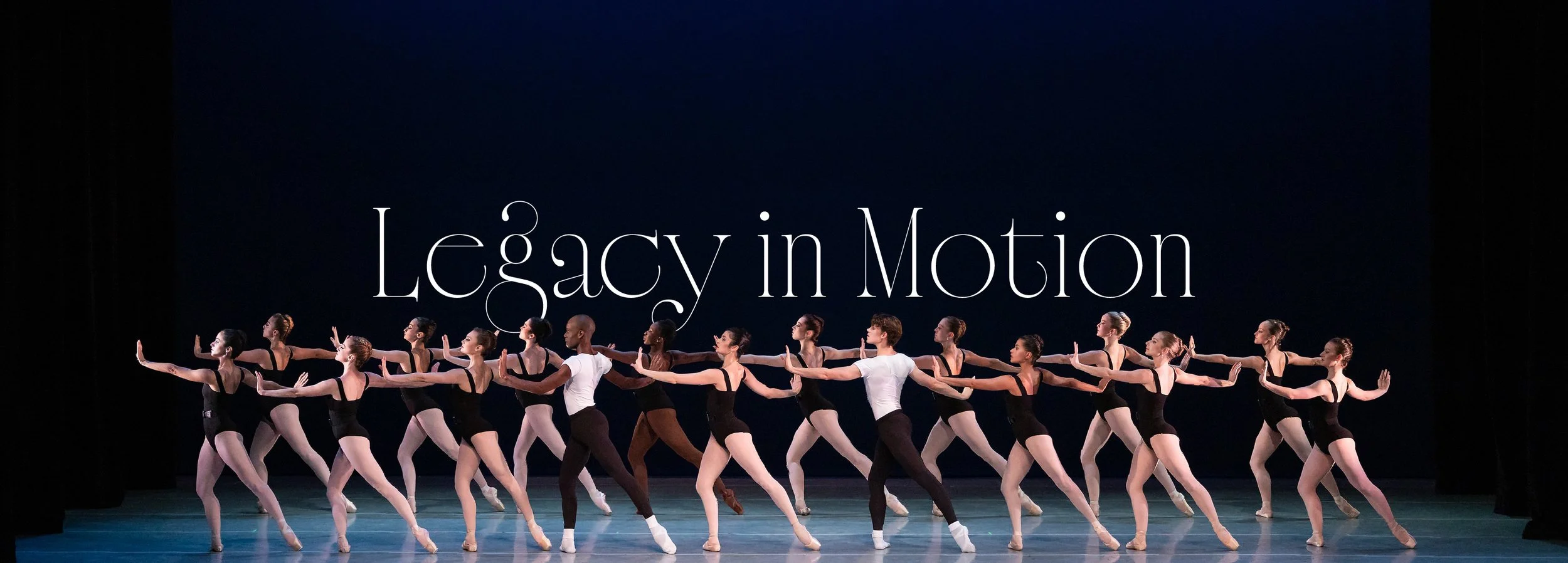
Honoring a living legacy.
Experience the timeless elegance of Legacy in Motion, a captivating performance by Indianapolis Ballet celebrating the enduring genius of George Balanchine. This special program features two of his iconic masterpieces, The Four Temperaments and Concerto Barocco, along with a world premiere by the Indianapolis Ballet artistic team, showcasing the power, precision, and poetic beauty of Balanchine’s choreography. Join us for an unforgettable evening honoring the living legacy of one of ballet’s greatest visionaries.
Performances
The Tobias Theater at Newfields
Friday, September 19, 2025, at 7:30pm
Saturday, September 20, 2025 at 7:30pm
Sunday, September 21, 2025 at 3:00pm
Quick Info
Mixed-repertoire production
Concerto Barocco, George Balanchine
The Four Temperaments, George Balanchine
World Premiere
Approximately 1.5 hours, one intermission
Recommended for ages 10 & up
Access Pass Members: If you are a part of the Access Pass Program and would like to purchase tickets, please call us at (317) 955-7525.
Venue
The Tobias Theater at Newfields
4000 North Michigan Road, Indianapolis, IN 46208
Free lot and garage parking is available.
Concerto Barocco
Choreography: George Balanchine
Music: Johann Sebastian Bach (Double Violin Concerto in D minor, B.W.V.1043)
Premiere: June 27, 1941, American Ballet Caravan, Teatro Municipal, Rio de Janeiro. Conductor: Emanuel Balaban. Violinists: Edmundo Blois, Salvador Piersant. (Open dress rehearsal: May 29, Little Theatre of Hunter College, New York. Conductor: Fritz Mahler.)
Balanchine said of this work: “If the dance designer sees in the development of classical dancing a counterpart in the development of music and has studied them both, he will derive continual inspiration from great scores.” In the first movement of the concerto, the two ballerinas personify the violins, while a corps of eight women accompany them. In the second movement, a largo, the male dancer joins the leading woman in a pas de deux. In the concluding allegro section, the entire ensemble expresses the syncopation and rhythmic vitality of Bach’s music.
This work began as an exercise by Balanchine for the School of American Ballet and was performed by American Ballet Caravan on its historic tour of South America. Later it entered the repertory of the Ballet Russe de Monte Carlo. In 1951, Balanchine permanently eliminated the original costumes and dressed the dancers in practice clothes, probably the first appearance of what has come to be regarded as a signature Balanchine costume for contemporary works. On October 11, 1948, Concerto Barocco was one of three ballets on the program at New York City Ballet’s first performance.
Johann Sebastian Bach (1685-1750) was born into a family of musicians successful for over two centuries. Although later in his career he became most noted for his choral and other church-related compositions, he also left a large body of instrumental music for solo instruments and ensembles. While his popular reputation was eclipsed by the fame of his sons, he was revered by musicians and composers. Finally in the 19th century, Mendelssohn brought his music to public attention and he became recognized as one of the greatest of all composers.
Repertory notes provided courtesy of and adapted for New York City Ballet Online Repertory Index. The George Balanchine Trust, www.balanchine.com. New York City Ballet, www.nycballet.com.
The Four Temperaments
Choreography: George Balanchine
Music: Paul Hindemith (Theme with Four Variations [According to the Four Temperaments] for string orchestra and piano, 1940, commissioned by George Balanchine)
Premiere: November 20, 1946, Ballet Society, Central High School of Needle Trades, New York. Conductor: Leon Barzin. Pianist: Nicholas Kopeikine
Balanchine choreographed The Four Temperaments for the opening program of Ballet Society, the forerunner of New York City Ballet. It is one of his earliest experimental works, fusing classical steps with a lean and angular style. The ballet is inspired by the medieval belief that human beings are made up of four different humors that determine a person’s temperament. Each temperament was associated with one of the four classical elements (earth, air, water, and fire), which in turn were the basis of the four humors (black bile, blood, phlegm, and bile) that composed the body.
In a healthy body, the humors were in balance. But if one became predominant it determined an individual’s temperament. Thus a person dominated by black bile was melancholic (gloomily pensive), by blood was sanguinic (headstrong and passionate), by phlegm was phlegmatic (unemotional and passive), and by bile was choleric (bad-tempered and angry). The titles of the ballet’s four movements — “Melancholic,” “Sanguinic,” “Phlegmatic,” and “Choleric” — reflect these principles.
Hindemith’s music was commissioned by Balanchine, an accomplished pianist who wanted a short work he could play at home with friends during his evening musicales. It was completed in 1940 and had its first public performance at a 1944 concert with Lukas Foss as the pianist.
Paul Hindemith (1895-1963), a key representative of the neo-classical school, is considered one of the greatest German composers of this century. He fled the Nazis (who banned his music) and was a professor of music at Yale from 1940-1953. A conductor, violinist, violist, pianist, and theorist, he wrote several books on music theory.
Repertory notes provided courtesy of and adapted for New York City Ballet Online Repertory Index. The George Balanchine Trust, www.balanchine.com. New York City Ballet, www.nycballet.com.
